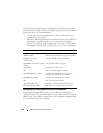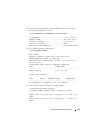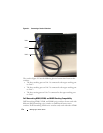
Managing a Switch Stack 171
9
Managing a Switch Stack
This chapter describes how to configure and manage a stack of switches.
The topics covered in this chapter include:
• Stacking Overview
• Default Stacking Values
• Managing and Monitoring the Stack (Web)
• Managing the Stack (CLI)
• Stacking and NSF Usage Scenarios
Stacking Overview
The Dell Networking N2000, N3000, and N4000 and series switches include a
stacking feature that allows up to 12 switches to operate as a single unit. The
N2000 and N3000 series switches have two fixed mini-SAS stacking
connectors at the rear. N2000 series switches will stack with other N2000
series switches and Dell Networking 3000 series switches stack with other
3000 series switches.
Dell Networking 4000 series switches stack with other Dell Networking 4000
series switches over front panel ports configured for stacking.
A stack of twelve 48-port N2000 or N3000 switches has an aggregate
throughput capacity of 576 Gigabits. Dell Networking N2000/N3000 stacking
links operate at 21 Gbps or 4.3% of total aggregate throughput capacity of a
full stack; therefore, it is recommended that operators provision large stacking
topologies such that it is unlikely that a significant portion of the stack
capacity will transit stacking links. One technique for achieving this is to
distribute uplinks evenly across the stack vs. connecting all uplinks to a single
stack unit or to adjacent stacking units.
Dell Networking N4000 series switches support high performance stacking
over front panel ports, allowing increased capacity to be added as needed,
without affecting network performance and providing a single point of
management. Up to twelve Dell Networking N4000 series switches can be


















